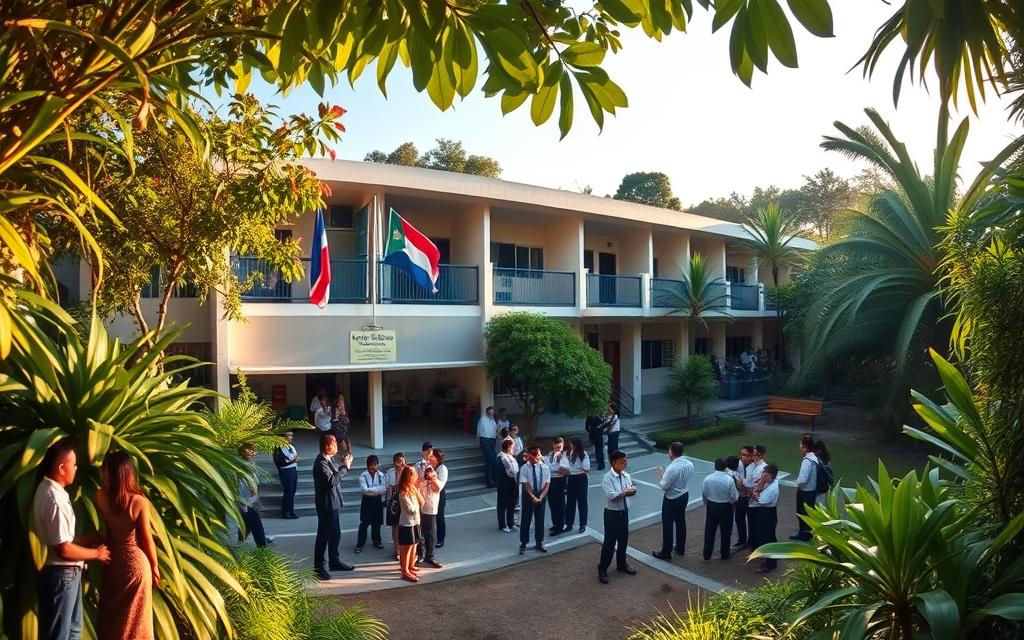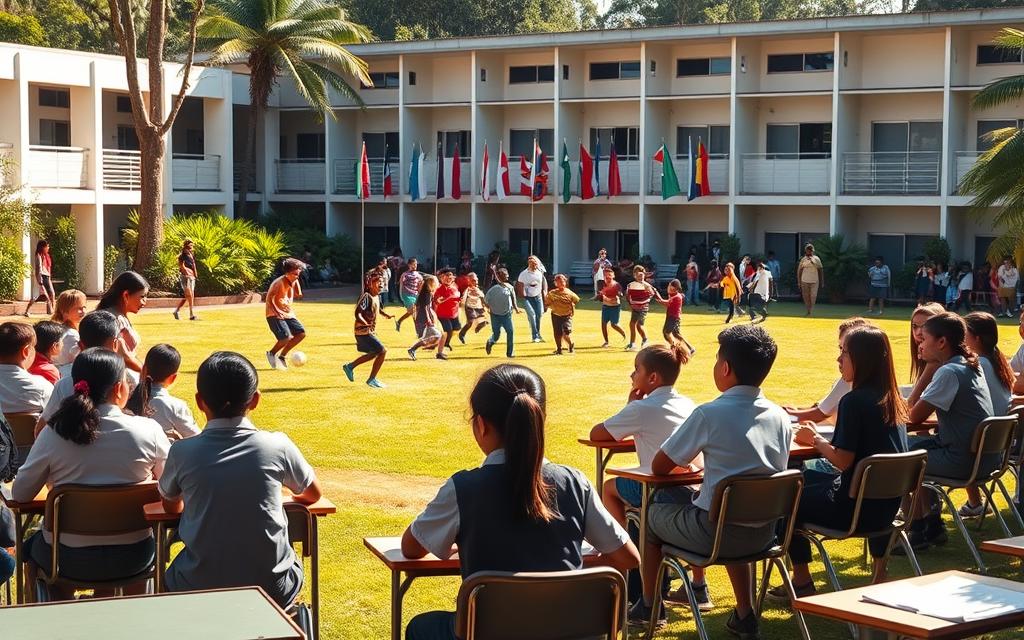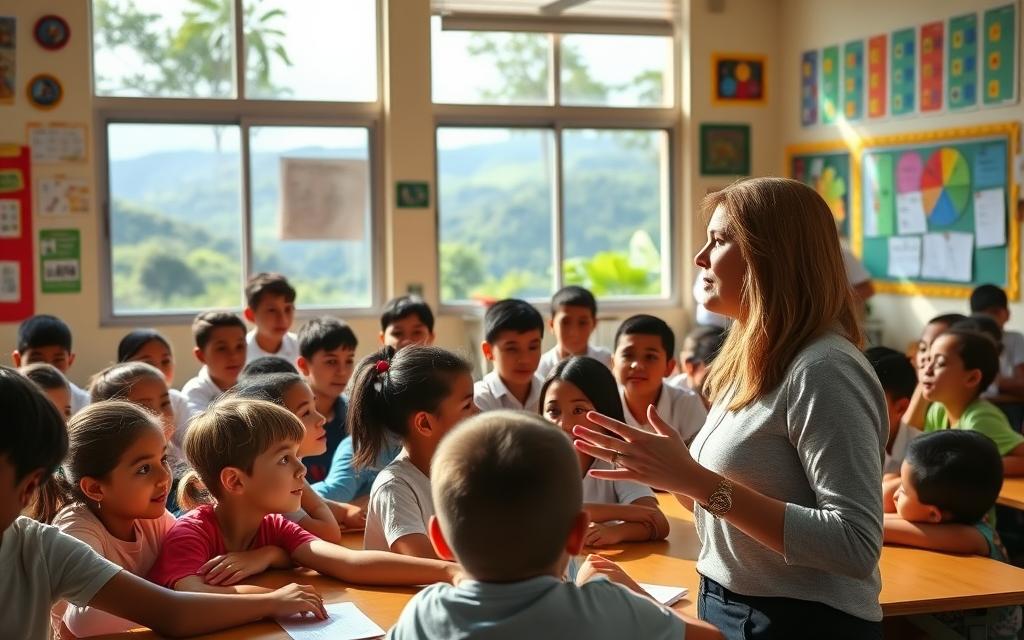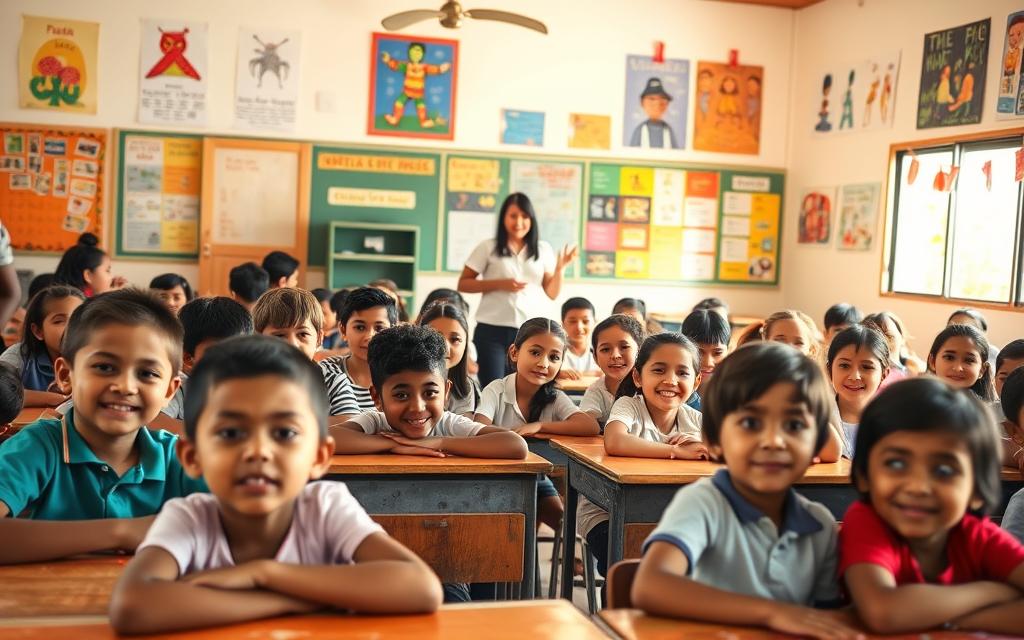Guide to Schooling for Expat Children in Costa Rica

Residency in Costa Rica has become an attractive choice for individuals and families seeking a better quality of life. With its high-quality, free education system, Costa Rica is a point of national pride, rivaling many developed countries.
For expat families, selecting the right schools is a critical decision that shapes their relocation experience. With over 70,000 American expats calling Costa Rica home, understanding the education landscape is essential. We will explore the various options available, including public, private, and international schools, to help expat families make informed decisions about their education.
The Costa Rican Education System: An Overview

The Costa Rican education system is highly regarded for its excellence and inclusivity. It has garnered international recognition for its high literacy rates and rigorous educational standards.
High Literacy Rate and Educational Standards
Costa Rica shines with its outstanding education system, often ranking in the global top 20%. It invests 6.5% of its GDP into education, one of the highest shares internationally. Thanks to this, almost 95% of the population can read and write. Costa Rican schools generally perform well on international standardized tests, providing reassurance to expat parents concerned about academic standards.
The remarkable 97.9% literacy rate in Costa Rica demonstrates the effectiveness of the country's educational approach and commitment to quality learning for all children.
School Year Structure and Calendar
The Costa Rican school year runs from February to December, with a two-week break in July and major holidays in April (Easter) and September (Independence Day). This unique structure differs from the northern hemisphere academic calendar, and it's essential for expat families to understand the schedule to plan accordingly.
The education system is divided into cycles, including preschool, primary, secondary, and higher education. This structure impacts the learning journey of students in Costa Rica, providing a comprehensive educational framework.
Schooling Options for Foreign Children in Costa Rica

The education system in Costa Rica offers a diverse range of schooling options for foreign children, catering to different needs and preferences. Expatriate families can choose from public, private, and international schools, each with its unique characteristics and benefits.
Public vs. Private Education
Public schools in Costa Rica are government-funded and offer free education with Spanish-language instruction. However, they typically require residency documentation, making them more suitable for families planning long-term stays. Private schools, on the other hand, include bilingual Costa Rican curriculum institutions, religious schools, and specialized educational approaches, offering more flexibility for expat families.
International and Bilingual Schools
International schools follow American, British, International Baccalaureate, or other foreign curricula with varying degrees of Spanish integration, providing educational continuity for temporary expats. Bilingual schools combine elements of the Costa Rican curriculum with instruction in another language, often English. These schools are ideal for families seeking a balanced cultural and linguistic experience for their children.
When choosing between these options, expat families should consider factors such as language barriers, cultural integration goals, budget constraints, and long-term educational plans. By understanding the different schooling options available, families can make informed decisions that best suit their children's needs.
International Schools: Curriculum and Offerings

For families moving to Costa Rica, international schools provide a familiar educational environment with curricula from North America, Europe, or international systems. These schools cater to the diverse needs of expat children, ensuring a smooth transition into the local education system.
American Curriculum Options
International schools in Costa Rica offer various curricula, including American programs. Schools like the American International School of Costa Rica, Country Day School, and Lincoln School are accredited by U.S. educational authorities and offer Advanced Placement (AP) courses. These programs prepare students for universities in the United States and other countries. For more information on adapting to life in Costa Rica, including learning Spanish, you can visit this resource.
British and International Baccalaureate Programs
In addition to American curricula, some international schools in Costa Rica follow British or International Baccalaureate (IB) programs. For instance, the International Christian School offers Cambridge International examinations and IGCSE certifications, while schools like the European School and United World College offer IB programs. These globally recognized credentials are highly valued by universities worldwide, providing students with a competitive edge in their future academic pursuits.
Bilingual Education in Costa Rica

The bilingual education system in Costa Rica is characterized by several distinct models, each with its own strengths and benefits for expat children. Costa Rica's bilingual schools offer a range of programs that cater to the needs of expat families, providing a balanced curriculum that includes both Spanish and English instruction.
Dual Language Models
The Dual Language model allocates equal instruction time to both Spanish and English across all subjects, producing the strongest bilingual outcomes according to research from the Costa Rican-American Chamber of Commerce education committee. This approach enables students to develop strong proficiency in both languages, preparing them for success in an increasingly globalized world.
Benefits for Expat Children
Bilingual education creates truly bilingual and bicultural students, offering a middle path between local immersion and international schooling. For expat children, bilingual education provides the opportunity to develop strong Spanish proficiency while maintaining academic progress in English. By evaluating bilingual programs based on teacher qualifications, language separation methodology, assessment protocols, and graduate outcomes, expat families can make informed decisions about their children's education in Costa Rica.
Public Schools: Full Spanish Immersion

Public schools in Costa Rica offer a unique educational experience for expat children through full Spanish immersion. This environment allows children to learn alongside predominantly Costa Rican classmates, promoting cultural integration and language acquisition.
Enrollment Requirements for Foreign Students
To enroll in a public school in Costa Rica, foreign students must provide specific documents, including an authenticated and translated birth certificate, previous school records, proof of residency or a residency application in process, vaccination records, and passport copies.
Academic Quality and Resources
Public schools in Costa Rica conduct all instruction in Spanish and follow the national curriculum. While tuition is minimal, the quality of education varies significantly between urban and rural areas. Schools in upper-middle-class neighborhoods typically offer stronger academic programs. However, public schools often lack resources to support non-Spanish speaking students initially.
Despite these challenges, public schools maximize language acquisition and cultural immersion for expat children, making them an attractive option for families looking to integrate into Costa Rican society.
Alternative Education Options
The landscape of education in Costa Rica is evolving, with alternative options emerging to meet the diverse needs of expat families. While traditional schooling remains the norm, many families are exploring alternative education paths that offer flexibility, innovation, and tailored learning experiences.
Homeschooling Status and Requirements
Homeschooling in Costa Rica exists in a legal gray area, as it is not explicitly recognized by local law. However, many expat families have successfully adopted this approach. To homeschool, families typically register with umbrella schools abroad, join homeschool cooperatives, and utilize online curriculum providers. They also prepare students for standardized tests through external validation, ensuring academic rigor and recognition.
Montessori and Waldorf Schools
Costa Rica is home to several Montessori and Waldorf schools that offer alternative pedagogical approaches. Schools like Monteverde Friends School and Centro Educativo Montessori provide unique learning environments with varying degrees of English instruction. These schools cater to families seeking child-centered education that fosters independence, creativity, and holistic development.
By exploring these alternative education options, expat families in Costa Rica can find the best fit for their children's educational needs, ensuring a smooth transition and a fulfilling academic experience.
Regional Differences in Educational Options
Costa Rica's diverse regions offer a range of educational options for expat families, varying significantly in quality and availability. As we explore the educational landscape, it becomes clear that the concentration and quality of schools are closely tied to expat population density.
Central Valley Schools
The Central Valley, encompassing areas like San José, Escazú, and Santa Ana, boasts the highest concentration of international and premium bilingual schools. These institutions offer a wide range of curricula, robust AP/IB programs, and well-established facilities, making this region a hub for high-quality education. For families residing in or near San José, there are numerous options to choose from, catering to different educational philosophies and curricula. To learn more about living in Costa Rica, including visa requirements, visit this resource for valuable information.
Coastal and Rural Area Options
In contrast, coastal regions such as Guanacaste (Tamarindo, Nosara, Flamingo) and the Central Pacific (Manuel Antonio, Jaco, Uvita) are developing their educational offerings. These areas are seeing a rise in bilingual schools and homeschool cooperatives, often with a focus on outdoor education and entrepreneurial skills. While the options may be more limited compared to the Central Valley, they cater specifically to the needs of expat communities, offering a unique educational experience. Transportation realities, including road conditions and traffic, play a significant role in determining school choice in these areas.
Language Considerations for Different Age Groups
When expat families move to Costa Rica, one crucial factor to consider is how their children's age affects their language learning experience. The ability to adapt to a new language environment varies significantly across different age groups, impacting the choice of schools and educational strategies.
Young Children and Language Acquisition
Research consistently shows that children under 10 adapt quickly to new language environments. According to Dr. Maria Rodriguez, a bilingual education specialist at Universidad de Costa Rica, "Young children acquire conversational fluency within 6-12 months in immersion settings due to their neural plasticity, which allows natural absorption of phonetics and grammar." For elementary-age children, parents should look for schools that offer initial ESL support, buddy systems pairing new arrivals with bilingual peers, and parent communication in English during the transition period.
Teenagers and Academic Language Proficiency
Adolescents face more significant language adaptation challenges, with academic language proficiency typically requiring 3-5 years to develop, potentially creating learning gaps during the transition. Effective schools for teenage students provide subject-specific vocabulary support, modified assessments during transition periods, bilingual resource materials, and content-based language instruction. Considering language factors when choosing schools is crucial, and in some cases, grade repetition or gap years for language acquisition before enrollment may be necessary for older students.
Costs and Financial Planning for Education
The cost of education in Costa Rica varies significantly across different types of schools, making financial planning essential for families considering a move to this Central American country. As we explore the educational landscape, it's crucial to understand the tuition fees and additional costs associated with different schooling options.
Tuition Comparison Across School Types
Educational costs in Costa Rica span a wide range, from top-tier international schools to public schools. Top International schools charge between $12,000 and $25,000 in annual tuition, while Mid-Range International schools cost between $8,000 and $12,000. Premium Bilingual schools range from $6,000 to $10,000, and Standard Bilingual schools from $4,000 to $7,000. Budget Private schools are more affordable, with fees between $2,000 and $4,000, and Public schools are essentially free, with minimal fees around $600.
When choosing a school, families must consider not only the tuition fees but also the curriculum and educational standards. For instance, international schools often follow curricula like the International Baccalaureate or American curriculum, which might be familiar to expat children. To learn more about residency requirements and how they might impact your choice of school, you can visit this resource for detailed information.
Hidden Costs and Budgeting Tips
Beyond tuition, several hidden costs can significantly impact a family's budget. These include uniforms ($200-500 annually), school lunches ($600-1,500 annually), field trips ($200-1,000 annually), extracurricular activities ($300-2,000 annually), technology requirements ($800-1,500), graduation fees ($300-1,200), and school events ($200-500 annually). Families should also be aware of potential discounts, such as sibling discounts (typically 10-20% for additional children) and financial aid based on need or merit at some institutions.
Currency considerations are also vital, as most international and premium bilingual schools denominate tuition in US dollars. This provides stability for dollar-earning expats but may introduce volatility for those earning in other currencies. Understanding these financial nuances is key to effective budgeting and financial planning for education in Costa Rica.
Cultural Integration and Social Adaptation
In Costa Rica, the type of school an expat family selects can either facilitate or hinder their cultural adaptation and social integration. The school community often becomes the primary social network for expatriate families, and the degree of local integration at school directly correlates to overall adaptation success.
Balancing Cultural Identity and Local Integration
Different schools offer varying levels of cultural integration. Public and bilingual schools provide high local integration, while premium international schools may offer lower levels of local integration. Expat families must consider their goals and choose a school that aligns with their desired level of cultural immersion.
Extracurricular Activities and Social Development
Extracurricular activities play a crucial role in the social development of expat children in Costa Rica. Schools in Costa Rica often emphasize sports like soccer, volleyball, and basketball. Additionally, community-based programs such as sports leagues, private music or art instruction, language exchange programs, and volunteer opportunities can supplement a child's social development and cultural integration.
Preschool and Kindergarten Options
The pre-primary education system in Costa Rica is designed to support the development of young children. Costa Rica's early education framework is divided into two main components: the Ciclo Materno Infantil and the Ciclo de Transición.
Private vs. Public Early Education
Public preschool is available at no cost, making it an attractive option for many families. However, private preschools offer additional benefits such as bilingual education, smaller class sizes, and more structured curricula, which are popular among expat families.
The cost of private preschools in Costa Rica can range from $200 to $800 per month, depending on the institution and the services provided.
Childcare Alternatives for Working Parents
For working parents, there are various childcare alternatives available, including nannies, au pairs, and babysitters. The cost for full-time care can range from $400 to $800 monthly.
When selecting a preschool or kindergarten, factors such as language of instruction, educational philosophy, teacher qualifications, and proximity to home should be considered to ensure the best fit for your child's needs.
Primary and Secondary Education Pathways
Understanding the educational pathways for primary and secondary education in Costa Rica is crucial for expat families. The country's education system is designed to provide a comprehensive foundation for students, with a curriculum that emphasizes core subjects such as mathematics, science, and social studies.
Elementary School Structure
The elementary school structure in Costa Rica covers Grades 1-6, focusing on developing fundamental skills in literacy, mathematics, science, and social studies. The curriculum is divided into cycles, with the first cycle (Grades 1-3) focusing on basic literacy and numeracy, and the second cycle (Grades 4-6) expanding on these subjects.
Public elementary schools in Costa Rica are budget-friendly, with class sizes typically ranging from 30 to 40 students. In contrast, private and international schools have smaller class sizes, usually between 10-20 students, offering a more personalized learning experience.
Middle and High School Options
Secondary education in Costa Rica is divided into two main phases: the Third Cycle (Grades 7-9) and Diversified Education (Grades 10-11/12). The Third Cycle provides a comprehensive secondary curriculum, while Diversified Education allows students to choose between academic tracks (such as science, humanities, and arts) or technical fields.
For those considering international schools, it's worth noting that graduation requirements differ from public schools. International schools often require credits, community service hours, and capstone projects, whereas public schools require passing the Bachillerato examination. Families can explore options like international schools in Costa Rica that cater to expat needs.
Understanding the Costa Rican Grading System
Costa Rica's schools utilize a multifaceted grading system that provides a thorough picture of student achievement. This system is designed to evaluate student performance comprehensively, using both numerical scores and letter grades.
Numerical and Letter Grading Scales
In Costa Rica, students receive grades on either a 100-point or a 10-point scale. The corresponding letter grades are S (Sobresaliente/Outstanding), N (Notable), Suf (Suficiente/Sufficient), and I (Insuficiente/Insufficient). The passing grade is typically set at 65 or 6.5, respectively. For instance, a student scoring 90 or above on a 100-point scale would receive an S, indicating outstanding performance.
Equivalency with International Standards
The Costa Rican grading system is generally comparable to international standards, facilitating the transfer of credits for students moving abroad. For expat families, understanding this equivalency is crucial, especially when applying to universities in their home countries or other international institutions. Some international and bilingual schools in Costa Rica maintain dual grading systems to ensure academic continuity for their students. Families considering residency in Costa Rica can explore options further on residency.
Documentation and Enrollment Process
Navigating the enrollment process for expat children in Costa Rica requires understanding the necessary documentation and timelines. When planning to enroll your child in a school in Costa Rica, it's essential to be aware of the required documents and procedures.
Required Documents for Foreign Students
To enroll your child in a Costa Rican school, you will need to provide several key documents. These include an apostilled or authenticated birth certificate translated into Spanish, previous school records that have been similarly authenticated and translated, passport copies for both the student and parents, translated vaccination records, and passport-sized photos. For public schools, proof of residency or residency in process is also mandatory, while private and international schools may initially accept tourist status but expect families to begin residency procedures.
Application Timelines and Deadlines
Most schools in Costa Rica start their enrollment process 3-6 months before the school year begins in February. International schools often have earlier deadlines and may maintain waiting lists for popular grades. It's crucial to check with the specific school you're interested in to understand their application timeline and ensure you don't miss critical deadlines. For more information on obtaining residency, which is a common requirement, you can visit this resource on residency in Costa Rica.
University Pathways and Higher Education
As expat families consider their children's educational journey in Costa Rica, understanding the higher education landscape becomes crucial. Costa Rica is home to several prestigious public universities that offer a range of academic programs.
Preparing for Costa Rican Universities
Public schools and many bilingual schools in Costa Rica follow curricula aligned with national university entrance requirements. The Bachillerato examination is a critical milestone for students aiming to join Costa Rican universities. International school students may need additional preparation to meet these requirements.
International University Preparation
International schools in Costa Rica often prepare students for universities abroad through programs like Advanced Placement, International Baccalaureate, or A-Level examinations. This prepares students for a global academic environment. Costa Rican universities, such as UCR and TEC, offer affordable education with tuition ranging from $50 to $200 per semester for expats.
Conclusion: Making the Right Choice for Your Family
With various educational options available, expat families in Costa Rica must consider several factors when choosing a schooling pathway for their children. When evaluating schools in Costa Rica, families should consider language preferences, cultural integration goals, budget constraints, and long-term educational plans.
There is no one-size-fits-all solution; the right choice depends on each family's unique circumstances, values, and educational priorities. Visiting potential schools and speaking with current expat families can provide valuable insights. Families should also consider the specific needs and personalities of their children when making this crucial decision.
For additional guidance on residency options and educational choices in Costa Rica, families can contact JAROS CR at www.jaroscr.com, info@jaroscr.com, or +(506)7182-8969. By carefully evaluating these factors and seeking expert advice, expat families can make informed decisions about their children's education in Costa Rica's diverse schools and education system.


